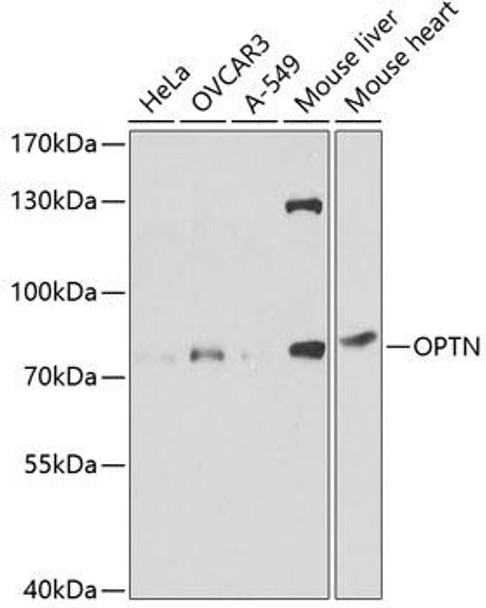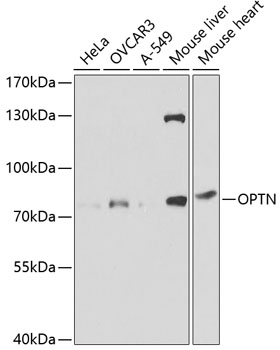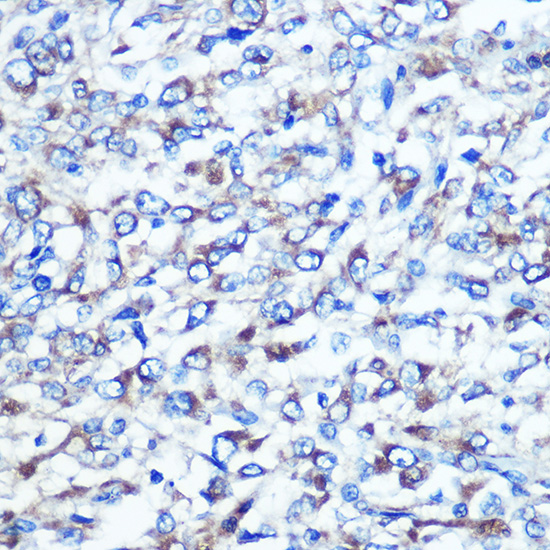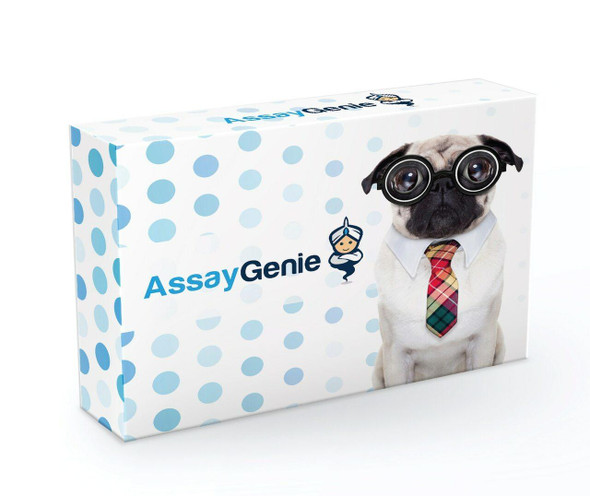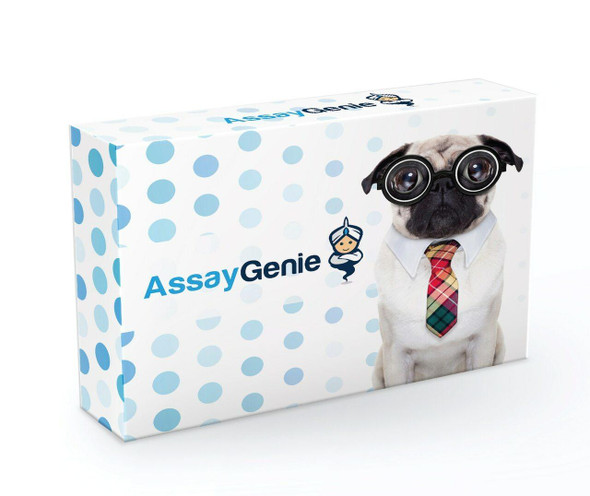Autophagy Antibodies
Anti-OPTN Antibody (CAB1845)
- SKU:
- CAB1845
- Product Type:
- Antibody
- Reactivity:
- Human
- Reactivity:
- Mouse
- Host Species:
- Rabbit
- Isotype:
- IgG
- Research Area:
- Autophagy
Description
| Antibody Name: | Anti-OPTN Antibody |
| Antibody SKU: | CAB1845 |
| Antibody Size: | 20uL, 50uL, 100uL |
| Application: | WB IHC IP |
| Reactivity: | Human, Mouse |
| Host Species: | Rabbit |
| Immunogen: | Recombinant fusion protein containing a sequence corresponding to amino acids 1-577 of human OPTN (NP_068815.2). |
| Application: | WB IHC IP |
| Recommended Dilution: | WB 1:500 - 1:2000 IHC 1:50 - 1:200 IP 1:50 - 1:200 |
| Reactivity: | Human, Mouse |
| Positive Samples: | HeLa, OVCAR3, A-549, Mouse liver, Mouse heart |
| Immunogen: | Recombinant fusion protein containing a sequence corresponding to amino acids 1-577 of human OPTN (NP_068815.2). |
| Purification Method: | Affinity purification |
| Storage Buffer: | Store at -20'C. Avoid freeze / thaw cycles. Buffer: PBS with 0.02% sodium azide, 50% glycerol, pH7.3. |
| Isotype: | IgG |
| Sequence: | MSHQ PLSC LTEK EDSP SEST GNGP PHLA HPNL DTFT PEEL LQQM KELL TENH QLKE AMKL NNQA MKGR FEEL SAWT EKQK EERQ FFEI QSKE AKER LMAL SHEN EKLK EELG KLKG KSER SSED PTDD SRLP RAEA EQEK DQLR TQVV RLQA EKAD LLGI VSEL QLKL NSSG SSED SFVE IRMA EGEA EGSV KEIK HSPG PTRT VSTG TALS KYRS RSAD GAKN YFEH EELT VSQL LLCL REGN QKVE RLEV ALKE AKER VSDF EKKT SNRS EIET QTEG STEK ENDE EKGP ETVG SEVE ALNL QVTS LFKE LQEA HTKL SEAE LMKK RLQE KCQA LERK NSAI PSEL NEKQ ELVY TNKK LELQ VESM LSEI KMEQ AKTE DEKS KLTV LQMT HNKL LQEH NNAL KTIE ELTR KESE KVDR AVLK ELSE KLEL AEKA LASK QLQM DEMK QTIA KQEE DLET MTIL RAQM EVYC SDFH AERA AREK IHEE KEQL ALQL AVLL KEND AFED GGRQ SLME MQSR HGAR TSDS DQQA YLVQ RGAE DRDW RQQR NIPI HSCP KCGE VLPD IDTL QIHV MDCI I |
| Gene ID: | 10133 |
| Uniprot: | Q96CV9 |
| Cellular Location: | Cytoplasm, Cytoplasmic vesicle, Golgi apparatus, Recycling endosome, autophagosome, perinuclear region, trans-Golgi network |
| Calculated MW: | 59kDa/65kDa |
| Observed MW: | 78kDa |
| Synonyms: | OPTN, ALS12, FIP2, GLC1E, HIP7, HYPL, NRP, TFIIIA-INTP |
| Background: | This gene encodes the coiled-coil containing protein optineurin. Optineurin may play a role in normal-tension glaucoma and adult-onset primary open angle glaucoma. Optineurin interacts with adenovirus E3-14.7K protein and may utilize tumor necrosis factor-alpha or Fas-ligand pathways to mediate apoptosis, inflammation or vasoconstriction. Optineurin may also function in cellular morphogenesis and membrane trafficking, vesicle trafficking, and transcription activation through its interactions with the RAB8, huntingtin, and transcription factor IIIA proteins. Alternative splicing results in multiple transcript variants encoding the same protein. |
| UniProt Protein Function: | optineurin: Plays an important role in the maintenance of the Golgi complex, in membrane trafficking, in exocytosis, through its interaction with myosin VI and Rab8. Links myosin VI to the Golgi complex and plays an important role in Golgi ribbon formation. Negatively regulates the induction of IFNB in response to RNA virus infection. Plays a neuroprotective role in the eye and optic nerve. Probably part of the TNF-alpha signaling pathway that can shift the equilibrium toward induction of cell death. May act by regulating membrane trafficking and cellular morphogenesis via a complex that contains Rab8 and hungtingtin (HD). May constitute a cellular target for adenovirus E3 14.7, an inhibitor of TNF-alpha functions, thereby affecting cell death. Defects in OPTN are the cause of primary open angle glaucoma type 1E (GLC1E). Primary open angle glaucoma (POAG) is characterized by a specific pattern of optic nerve and visual field defects. The angle of the anterior chamber of the eye is open, and usually the intraocular pressure is increased. The disease is asymptomatic until the late stages, by which time significant and irreversible optic nerve damage has already taken place. Defects in OPTN are a cause of susceptibility to normal pressure glaucoma (NPG). Defects in OPTN are the cause of amyotrophic lateral sclerosis type 12 (ALS12). It is a neurodegenerative disorder affecting upper motor neurons in the brain and lower motor neurons in the brain stem and spinal cord, resulting in fatal paralysis. Sensory abnormalities are absent. Death usually occurs within 2 to 5 years. The etiology of amyotrophic lateral sclerosis is likely to be multifactorial, involving both genetic and environmental factors. The disease is inherited in 5-10% of the cases. 3 isoforms of the human protein are produced by alternative splicing. |
| UniProt Protein Details: | Protein type:Inhibitor Chromosomal Location of Human Ortholog: 10p13 Cellular Component: nucleoplasm; Golgi membrane; Golgi apparatus; recycling endosome; perinuclear region of cytoplasm; cytoplasmic membrane-bound vesicle; cytoplasm; autophagic vacuole; trans-Golgi network; cytosol; nucleus Molecular Function:protein C-terminus binding; protein binding; polyubiquitin binding; Rab GTPase binding Biological Process: cell death; macroautophagy; Golgi to plasma membrane protein transport; negative regulation of receptor recycling; protein targeting to Golgi; mitotic cell cycle; negative regulation of I-kappaB kinase/NF-kappaB cascade; signal transduction; defense response to Gram-negative bacterium; G2/M transition of mitotic cell cycle; regulation of I-kappaB kinase/NF-kappaB cascade; Golgi organization and biogenesis Disease: Glaucoma, Normal Tension, Susceptibility To; Glaucoma, Primary Open Angle; Amyotrophic Lateral Sclerosis 12 |
| NCBI Summary: | This gene encodes the coiled-coil containing protein optineurin. Optineurin may play a role in normal-tension glaucoma and adult-onset primary open angle glaucoma. Optineurin interacts with adenovirus E3-14.7K protein and may utilize tumor necrosis factor-alpha or Fas-ligand pathways to mediate apoptosis, inflammation or vasoconstriction. Optineurin may also function in cellular morphogenesis and membrane trafficking, vesicle trafficking, and transcription activation through its interactions with the RAB8, huntingtin, and transcription factor IIIA proteins. Alternative splicing results in multiple transcript variants encoding the same protein. [provided by RefSeq, Jul 2008] |
| UniProt Code: | Q96CV9 |
| NCBI GenInfo Identifier: | 317373403 |
| NCBI Gene ID: | 10133 |
| NCBI Accession: | Q96CV9.2 |
| UniProt Secondary Accession: | Q96CV9,Q5T672, Q5T673, Q5T674, Q5T675, Q7LDL9, Q8N562 Q9UET9, Q9UEV4, B3KP00, D3DRS4, D3DRS8, |
| UniProt Related Accession: | Q96CV9 |
| Molecular Weight: | 577 |
| NCBI Full Name: | Optineurin |
| NCBI Synonym Full Names: | optineurin |
| NCBI Official Symbol: | OPTN |
| NCBI Official Synonym Symbols: | NRP; FIP2; HIP7; HYPL; ALS12; GLC1E; TFIIIA-INTP |
| NCBI Protein Information: | optineurin; FIP-2; HIP-7; nemo-related protein; huntingtin yeast partner L; E3-14.7K-interacting protein; Huntingtin interacting protein L; huntingtin-interacting protein 7; huntingtin-interacting protein L; optic neuropathy-inducing protein; transcrption |
| UniProt Protein Name: | Optineurin |
| UniProt Synonym Protein Names: | E3-14.7K-interacting protein; FIP-2; Huntingtin yeast partner L; Huntingtin-interacting protein 7; HIP-7; Huntingtin-interacting protein L; NEMO-related protein; Optic neuropathy-inducing protein; Transcription factor IIIA-interacting protein; TFIIIA-IntP |
| Protein Family: | Optineurin |
| UniProt Gene Name: | OPTN |
| UniProt Entry Name: | OPTN_HUMAN |

